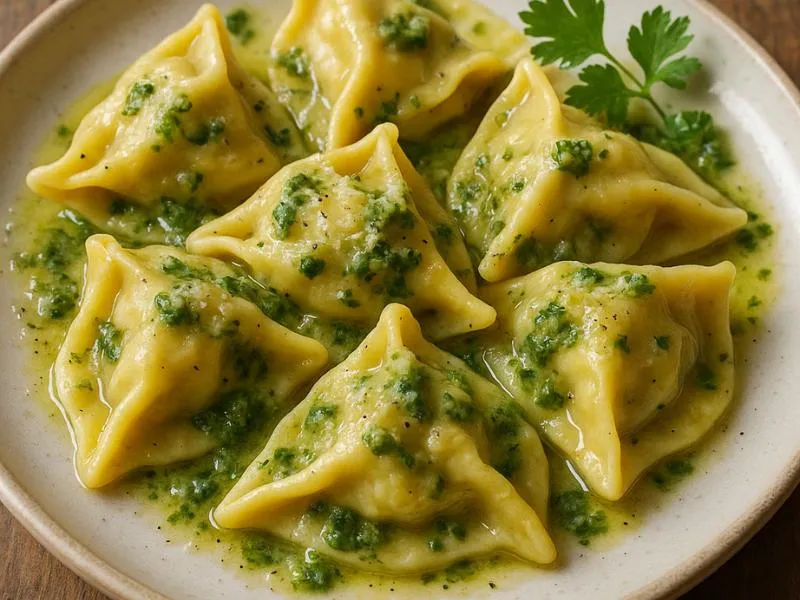Pansotti
Stuffed pasta crescents filled with herbs and ricotta, traditionally served with walnut sauce.
👉 View Authentic Recipe 👈
About This Dish
Pansotti are distinctive triangular or half-moon shaped stuffed pasta originating from the Ligurian Riviera, particularly the area around Genoa and the picturesque Portofino promontory. The name derives from “pansa” in Ligurian dialect, meaning “belly” or “paunch,” referencing their plump, stuffed appearance. Unlike many other stuffed pasta varieties across Italy, authentic pansotti are filled with a mixture called “preboggion” - a traditional blend of wild herbs and greens that typically includes borage, dandelion, endive, and other foraged greens.
Traditional pansotti are most commonly served with salsa di noci (walnut sauce), a creamy, aromatic sauce made from ground walnuts, garlic, bread soaked in milk, and a touch of marjoram. This pairing represents one of Liguria’s most distinctive culinary traditions, reflecting the region’s abundance of walnut trees in the inland hills and the historical practice of foraging wild herbs along the Mediterranean coast.
As a dish born from peasant traditions, pansotti were historically prepared for special occasions and celebrations, particularly during spring when fresh herbs were abundant. The combination of foraged greens and locally grown walnuts exemplifies Ligurian cuisine’s resourceful nature and deep connection to the region’s terroir, utilizing ingredients found in the mountains, valleys, and coastline of this narrow strip of land between the Apennine mountains and the Mediterranean Sea.
🧑🍳 Analyzed by CucinaBot
Why This Dish Works
Pansotti exemplifies the culinary principle of complementary flavors and textures. The slight bitterness of the wild greens is balanced by the creamy, sweet nuttiness of the walnut sauce. This combination activates multiple taste receptors simultaneously, creating a complex flavor profile. The pasta’s thick edges versus thin center creates textural contrast, while the walnut sauce’s fat content helps carry the herbal aromatics across the palate, enhancing the overall sensory experience.
Key Success Factors
- Proper Herb Balance: The filling should contain a variety of greens (at least 3-5 different types) to achieve complexity, with borage being essential for authentic flavor
- Dough Thickness: The pasta must be rolled thin enough to cook properly but thick enough at the edges to prevent bursting
- Walnut Processing: Walnuts should be ground just until mealy, not to a paste, preserving some texture in the sauce
- Sauce Consistency: The walnut sauce should coat the back of a spoon but remain pourable, neither too thick nor too runny
Common Pitfalls
Many non-authentic recipes substitute the traditional herb mixture with spinach alone, dramatically simplifying the complex flavor profile that defines real pansotti. Another common mistake is overcooking the pasta, which causes it to become mushy and lose its structural integrity. The walnut sauce is often made too thin or overprocessed into a completely smooth puree, whereas authentic versions maintain some textural elements.
How to Judge Authenticity
When reviewing recipes, look for these markers of authenticity:
- Includes a diverse mixture of herbs in the filling (preboggion), not just spinach
- Specifies borage as one of the filling ingredients
- Uses walnut sauce (salsa di noci) rather than tomato sauce or butter
- Includes stale bread soaked in milk as a thickening agent in the walnut sauce
- Shapes the pasta into triangular or half-moon forms, not square ravioli